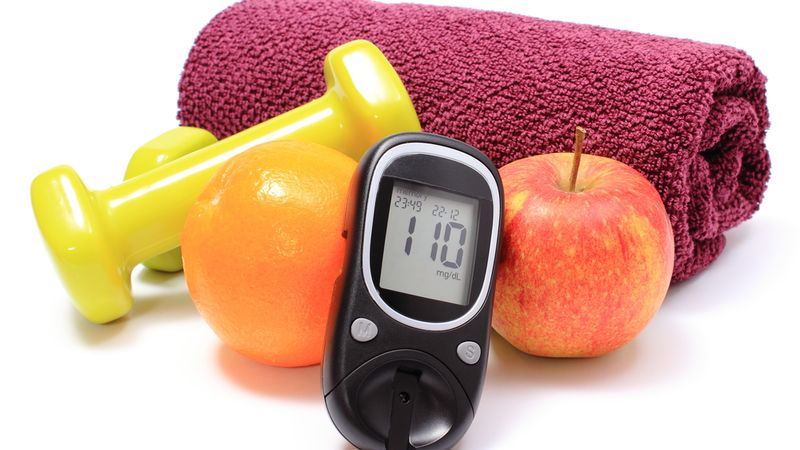

Our Review Process
Our articles undergo extensive medical review by board-certified practitioners to confirm that all factual inferences with respect to medical conditions, symptoms, treatments, and protocols are legitimate, canonical, and adhere to current guidelines and the latest discoveries. Read more.
Our Editorial Team
Shifa Fatima, MSc.
Author
Dr. Apoorva T, MHM.
MEDICAL ADVISOR
Diabetes and Fitness
If you’re going to exercise, you need to see how it affects your blood sugar. If you have diabetes or prediabetes, try this simple experiment. Check your blood sugar values before you exercise, and then take it again afterwards to see and understand what exercise does to your blood sugar. During exercise, insulin needs to be available to help sugar get into your cells, but must also keep a low profile because a high level of insulin in the blood tells the liver not to release glucose, which you need to keep your energy up. So lets learn some basics on the relationship between diabetes and exercise and see how you can use this to your advantage. Also know how to reverse diabetes.
Table of Contents
Exercise and Blood Glucose
Diabetes is of two types - one where the insulin is not secreted in a sufficient quantity and second where your body cannot use the insulin that is secreted in sufficient quantity. The latter is also known as insulin resistance. Either way, the result is high levels of blood sugar. When you exercise, your muscles take up the glucose from your blood for energy. Thus regulating your blood glucose levels. Even if you are insulin resistant, exercising improves the effect of insulin, meaning it can also correct insulin resistance with time.
Several different factors play a role in lowering or raising the blood sugar levels in one’s body. Some of the major aspects would be – diet, stress, sleep cycle, exercise, etc. Yes, all of these things and a lot more can play a huge role in the overall sugar levels. One of the major things each doctor emphasizes when a person is diagnosed with diabetes is the importance of diabetes fitness. However, this exercise would also need to be well-planned and curated specifically to the needs of each person and how their bodies might respond to particular workout regimes. That being said, each day, before a workout, the blood sugar levels might be different, this might also alter the plans in the schedule and type of exercises. Know about is honey good for diabetes?.
Here is how exercise can affect blood sugar levels:
- The effect of any physical activity like walking, running, or even hardcore strength training can play a role in blood sugars as the muscles use all the extra glucose in the body in the form of energy during exercises. These activities can lower blood sugar levels for up to 24 hours, making the body more sensitive to insulin.
- Being active regularly can provide long-term health benefits to a person with diabetes as it helps lower the overall HbA1c levels. Also read about benefits of dates for diabetes
Type 2 Diabetes and Exercising
In Type 2 diabetes, the insulin that is secreted is not effective and fails to regulate blood sugar levels. The risk of type 2 diabetes is greater in overweight individuals. It is also harder to control weight gain in individuals who have type 2 diabetes. It is proven that losing weight and maintaining a healthy weight helps in regulating blood sugar levels. Exercising, as mentioned earlier, can help regulate your blood glucose levels. It can also help you to maintain a healthy weight by increasing your muscle mass.
Many times, when a person with diabetes has hyperglycemia, they are advised to drink a lot of water and maybe go take a walk. Of course, this is subjective to the person, and the exact blood sugar reading on the glucometer. However, the benefits of exercise for a person with diabetes cannot be overstated as exercise and blood glucose are highly connected. There are several obvious and even underlying advantages to working out as it helps in lowering the blood sugars but also in several other ways like – improving cholesterol levels, strengthening muscles and bones, reducing stress with the release of endorphins, etc. It also improves the body’s sensitivity to insulin.
Other benefits of exercising for a person with diabetes could be:
- A lower HbA1c by almost 0.7 percentage points in different people.
- Increased activity by the heart resulting in lesser cardiovascular diseases.
- Lowering the bad cholesterol levels in the body
- Using the excess sugars present in the bloodstream, thus reducing the need for insulin, etc
These are a few of the exercises that you can be engaging in if you have diabetes:
- Cardio exercises like – aerobics, jogging, walking, dancing, Zumba, etc are known to be beneficial in lowering the blood sugars among people with diabetes. Check your sugar levels before any hardcore cardio exercises to ensure to not drop significantly low.
- Strength training – combined with cardio, these exercises can prove to be highly beneficial for the muscles
- Resistance training – this form of workout particularly helps to reduce abdominal obesity and insulin resistance. In tandem with cardio, these work best.
- Walking – if you are not too much into working out, walking in the park or on the terrace may also help. Walking is associated with lower levels of heart disease. Also know about yoga for diabetes.
Importance of Fitness if you are Diabetic
1. Blood Sugar Levels
Diabetes causes constant high blood glucose levels. To reverse your symptoms, diet optimization & exercising is your answer.
2. Glycation
Prolonged high blood sugars are associated with the accumulation of sugars in your joints. This can make your joints brittle and still. Exercising will help in delaying it.
3. Peripheral Neuropathy
Peripheral neuropathy in simple language is nerve damage that can lead to loss of sensation in your feet. Staying feet can prevent nerve damage.

Fitness tips for diabetics
1. Consult an expert
Consult your doctor before you start working out. They will guide you with precautions to be taken while you exercise.
2. Do not push your body off-limits right from the beginning.
Take baby steps and gradually increase the intensity of your workout.
3. Check your blood sugar
Keep a constant check on your blood sugar levels to be on the safer side before you begin working out.
4. Carry simple carbs
There is a chance of a drop in blood glucose levels when you work out to avoid a mishap and keep something like fruit with you.
5. Hydrate
Even if you do not feel thirsty, keep sipping on water throughout your workout to keep yourself hydrated.
6. Yoga
For individuals who have joint problems, yoga or Pilates can be a great option for you to stay fit.
7. Mind your feet
Keep checking on your feet for any blisters or wounds every day since there is a risk of peripheral neuropathy. In case of any of these, contact your doctor.
The 15-15 Rule
There are a few simple steps to this rule
- Check your blood sugar levels
- For a reading lower than 100 mg/dL, take about 15-20 grams of carbs to raise it
- 4 glucose tablets (4gms per tablet)
- 15 grams of glucose gel
- ½ cup of juice or soda
- 1 tablespoon sugar or honey
- Check sugar levels after 15 minutes. If it is still below 100 mg/dL, repeat the intake of 15grams of carbs.
- This process should be conducted every 15 minutes until the blood sugar levels rise up to at least 100mg/dL
This process is important because low sugar spells are often known to be fatal as a person can lose consciousness. This is why it becomes important to treat them as soon as the level falls down below a certain benchmark. Additionally, especially before working out, this process becomes vital as exercising with low blood sugar can also result in severe complications. Ensure that your sugar levels are high enough to be able to work out with the strength, energy, and adequate support from your body.
Bottom Line
Fitness is crucial in diabetic individuals. Whether it be to lose weight or reverse symptoms, one should make it a point to strive for to sustain in the long run of life. Apart from the many consequences of high blood sugar levels, cardiovascular diseases, Diabetic Neuropathy are the biggest risk. This can be avoided by focusing on fitness. Also know how to reverse prediabetes.
FAQs
Does walking lower blood sugar immediately?
Walking is a good way to burn extra calories and use the muscles of the body. The biggest muscle groups – the legs are used which take up a lot of the extra sugars floating within the bloodstream. This results in lowering the blood sugars. While it may not be immediate, it does happen pretty quickly.
What is the best time for diabetics to exercise?
By calculation, the best time to exercise would be 2-3 hours post meals when the blood sugars are on the higher side. This would lead to a lesser risk of hypoglycemia. Mornings, after a snack as decided with your dietician might also be a good idea. Read more about the type 2 diabetes exercise.
What is the importance of warm up before exercise?
Warming up is an important step that should not be skipped before any form of exercise as it helps to heat up the muscles to an extent that they do not lock up or freeze while working out. Loosen up the rigid muscle groups within the body before you begin something extensive and help the oxygen flow freely all throughout. Read more about why warm up is important before any exercise.
References
- https://www.ncbi.nlm.nih.gov/pmc/articles/PMC2992225/
- https://diabetesjournals.org/care/article/39/11/2065/37249/Physical-Activity-Exercise-and-Diabetes-A-Position
Disclaimer
This website's content is provided only for educational reasons and is not meant to be a replacement for professional medical advice. Due to individual differences, the reader should contact their physician to decide whether the material is applicable to their case.








